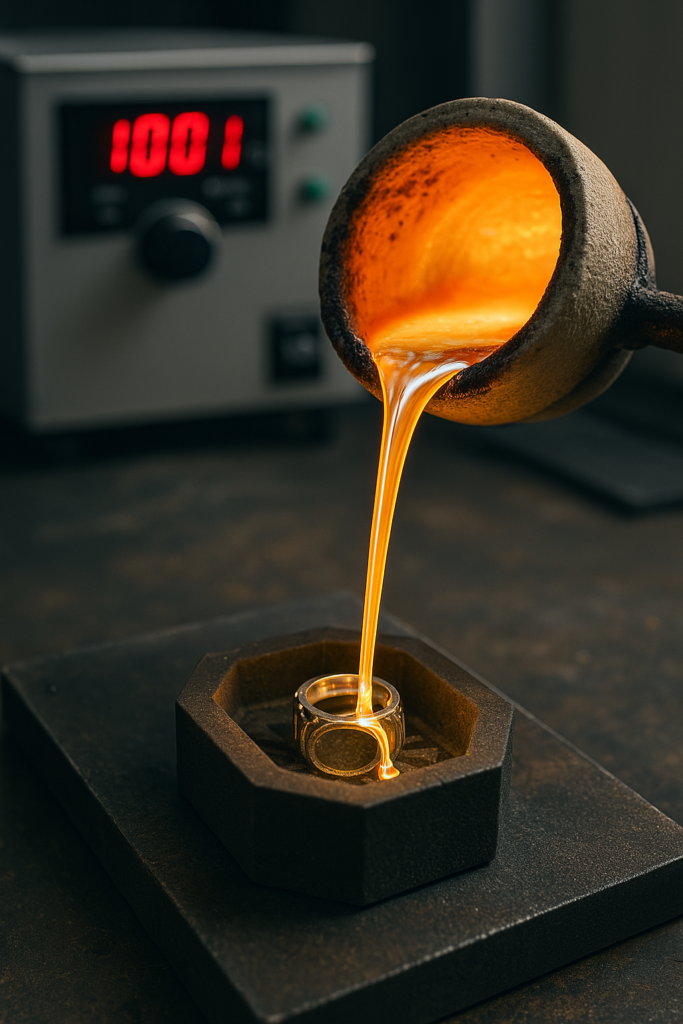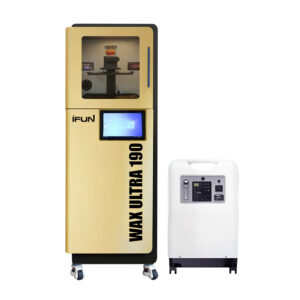When it comes to jewelry, a ring is more than just an accessory—it represents emotion, identity, and status. In today’s market, consumers demand rings that are not only visually appealing but also durable and crafted to perfection. Whether it’s a wedding band, an engagement ring, or a statement piece, the quality of the metal and the precision of the casting process make all the difference. In this article, we delve into the unique physical properties of precious metals like gold, silver, platinum, and palladium, and explore their casting curves, temperature requirements, and practical casting tips. We’ll also provide actionable advice on improving casting equipment and techniques to help manufacturers and consumers achieve the ideal balance between beauty and durability.

Understanding Precious Metals and Their Casting Curves
Key Temperature Concepts in Metal Casting
- Melting Point:
Every metal has a unique melting point—the temperature at which it transitions from solid to liquid. For example, pure gold melts at about 1,064°C, while silver melts at approximately 961°C. - Pouring Temperature:
This is the temperature of the molten metal when it is poured into the ring mold. It must be slightly higher than the melting point to ensure optimal flow and complete mold filling. For instance, the pouring temperature for 18K gold is lower than that for pure gold due to the presence of alloying elements. - Casting Temperature (Mold Preheat Temperature):
The temperature at which the mold is preheated influences how quickly the metal cools and solidifies. A cold mold may lead to rapid cooling, causing incomplete filling or cold shuts, whereas an overly hot mold might cause surface defects or oxidation.
How These Parameters Affect Your Cast Ring
- Flowability:
A higher pouring temperature improves the metal’s flowability, ensuring it fills intricate mold details. However, too high a temperature can accelerate oxidation and create bubbles. - Filling Effectiveness:
The right balance of pouring and casting temperatures ensures that the molten metal fills every nook and cranny of the mold, avoiding gaps and discontinuities. - Cooling Rate:
The cooling rate affects the metal’s grain structure. An optimal cooling process results in a refined microstructure, enhancing the mechanical properties and surface finish of the final cast ring.
Essential Physical Parameters of Common Precious Metals
Understanding the basic physical characteristics of each metal helps in selecting the best material for your design.
Gold (Au)
- Melting Point: Approximately 1,064°C for pure gold. Alloy variations like 18K and 14K differ due to additional metals.
- Density: About 19.3 g/cm³.
- Thermal Expansion Coefficient: Roughly 14.2 × 10⁻⁶/°C.
- Characteristics: Gold is highly malleable and ductile, making it excellent for intricate designs and fine detailing in cast ring jewelry.
Silver (Ag)
- Melting Point: About 961°C for pure silver; sterling silver (92.5% silver) has a slightly lower melting point.
- Density: Approximately 10.5 g/cm³.
- Thermal Expansion Coefficient: Around 18.9 × 10⁻⁶/°C.
- Characteristics: Silver boasts superior flowability, making it ideal for complex molds. However, it oxidizes easily during casting, so careful protection measures are required when casting silver rings.
Platinum (Pt)
- Melting Point: Near 1,768°C.
- Density: Roughly 21.4 g/cm³.
- Thermal Expansion Coefficient: About 9.0 × 10⁻⁶/°C.
- Characteristics: With a high melting point and density, platinum demands specialized casting equipment. Its excellent durability and hypoallergenic properties make it the top choice for high-end and everyday luxury rings.
Palladium (Pd)
- Melting Point: Approximately 1,555°C.
- Density: Around 12.0 g/cm³.
- Thermal Expansion Coefficient: Roughly 11.0 × 10⁻⁶/°C.
- Characteristics: Palladium offers a lighter alternative to platinum with comparable elegance. Its cost-effectiveness and resistance to oxidation make it popular for modern, minimalist ring designs.
Practical Casting Tips & Equipment Upgrades
Upgrading Your Casting Equipment
- High-Temperature Casting Equipment:
- Induction Furnaces: These provide precise temperature control, ensuring the metal reaches and maintains the required temperature for optimal flow without excessive oxidation.
- Vacuum and Pressure Casting Machines: These are essential for high-density metals like platinum, as they minimize gas entrapment and improve mold filling.
- Centrifugal Casting Machines: Ideal for intricate designs, these machines enhance metal flow, ensuring every fine detail in a cast ring is perfectly replicated.
- Mold Preheat Control:
- Maintain the mold at an optimal preheat temperature to prevent rapid cooling that can cause casting defects.
- Utilize infrared thermometers to monitor and maintain consistent mold temperatures.
- Temperature Monitoring Systems:
- Integrate digital temperature controllers and data logging systems in your casting area. These tools help in tracking and adjusting temperature fluctuations during the casting process, ensuring consistency and high-quality cast ring.
- Latest Technological Advancements:
- 3D Printed Molds: High-precision resin molds allow for complex geometries and finer details. Digital designs can optimize the placement of gates and vents, reducing common casting defects.
- CNC Integration: Combining CNC machining with casting processes minimizes manual errors in wax mold preparation and enhances overall consistency.
Addressing Common Casting Challenges
- Metal Oxidation:
- Cause: Exposure of molten metal to air can create an oxidation layer.
- Solution: Cast in an inert atmosphere (using argon gas) and apply anti-oxidizing fluxes like borax to protect the metal.
- Mold Damage:
- Cause: Insufficient preheating or high pouring temperatures can stress the mold.
- Solution: Optimize mold preheating and use durable, heat-resistant materials such as high-temperature plaster or ceramic.
- Casting Defects (Porosity, Shrinkage, Incomplete Filling):
- Solutions:
Defect Type Cause Remedy Porosity Air or moisture in the molten metal Use vacuum casting and maintain appropriate mold heat. Shrinkage Uneven cooling leading to contraction Adjust pouring temperature and integrate risers. Incomplete Filling Insufficient metal flow or rapid cooling Optimize gate design and increase the pouring temperature.
- Solutions:
Quality Control & Process Optimization
- Refine Your Melting Environment:
Keep your melting crucibles clean and regularly maintained to avoid contamination. - Automate Temperature Control:
Using automated systems minimizes human error and stabilizes the casting process. - Digital Quality Monitoring:
Employ non-destructive testing methods like X-ray or ultrasonic inspection to detect internal flaws, and use AI analysis to further optimize casting parameters.
The Best Path for Casting Rings
Crafting the perfect cast ring requires a deep understanding of the materials, precise control of the casting process, and continuous adaptation of new technologies. By leveraging advanced equipment, optimizing mold temperatures, and addressing common casting challenges, manufacturers can produce high-quality rings that not only meet but exceed consumer expectations. Whether you’re casting silver rings with intricate details or designing luxurious platinum bands, the right balance of technical expertise and innovative techniques will ensure that your jewelry stands out in a competitive market.
Embrace these strategies to refine your casting process, enhance product quality, and create timeless pieces that embody both beauty and durability. Happy casting!

